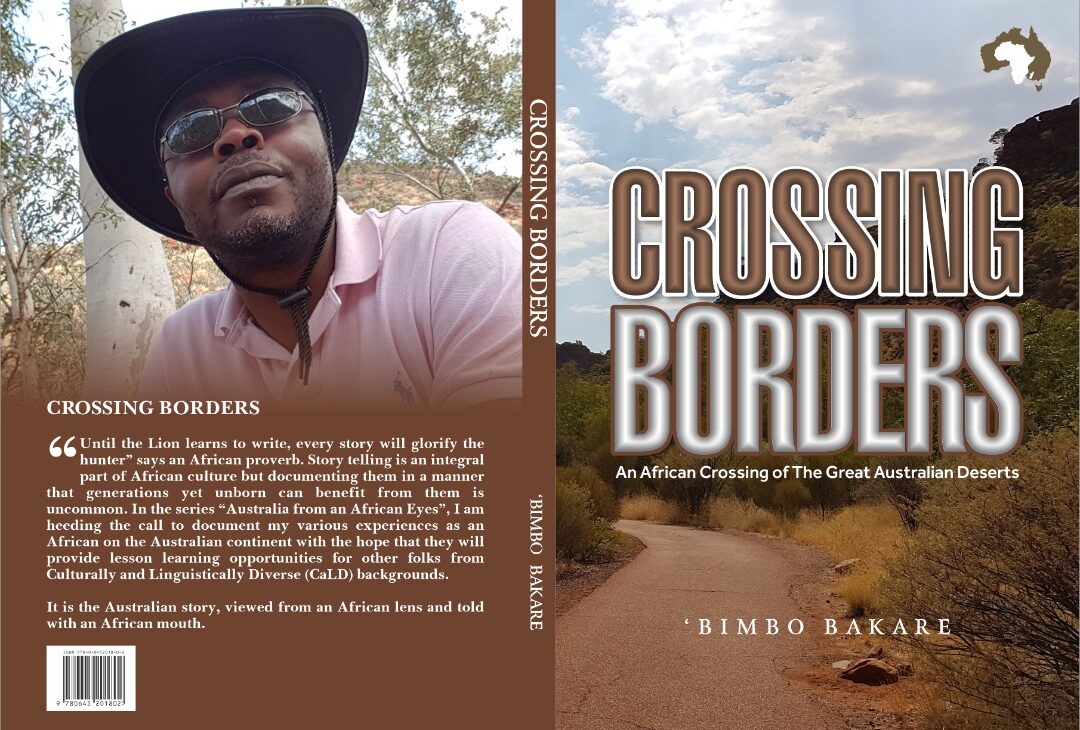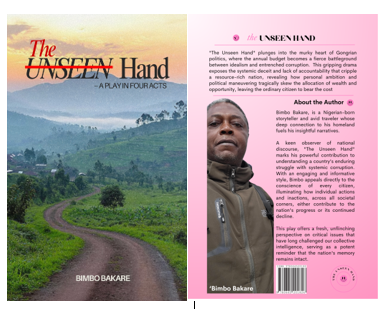Published Works
Moria’s Scar: Agbekoya Uprising
Agbekoya Uprising, published as Moria’s Scar: Agbekoya Uprising, is a compelling story of a young girl who experienced a traumatic event that changed the course of her life for 27 years, until she chose to confront and understand the cause of her traumatic experience.
In unravelling the story, Moria, through her eyes and experiences revealed the complex socio-political events that pervades Western Nigeria in the late sixties
You can read more about the finished work, now published in Kindle by clicking here or the button below to download a copy
Yet To be Published
CROSSING BORDERS – An African Crossing of The Great Australian Deserts
Australia, from an African’s Eyes I

Australia is a vast canvas painted with the fiery hues of the outback, fringed by sapphire coasts and echoing with the whispers of ancient cultures. This book presents a picture of this breathtaking panorama unfolding through the fresh, insightful gaze of an African traveller.
This isn’t just another travelogue; it’s a vibrant cultural exchange etched onto the dusty roads leading from the sun-drenched shores of Perth to the mystical heartland of Uluru. The writer takes the reader along on an extraordinary journey where the familiar collides with the utterly novel, feel the rumble of the wheels as we traverse the legendary Nullarbor Plain, a seemingly endless horizon that hums with its own stark beauty and strange sounds. Navigate the ochre-red dunes of the Great Victoria Desert, where survival is an art form and the silence speaks volumes. Then, be mesmerized by the spiritual grandeur of the Northern Territory, culminating in the awe-inspiring presence of Uluru, a monolith steeped in Dreamtime stories.
But this adventure is more than just stunning vistas. It’s a tapestry woven with the threads of human connection. Encounter the diverse faces of Australia, witness the subtle dance of cultural understanding, the gentle challenges of navigating new customs, and the unexpected moments of shared humanity that bridge continents.
Through the eloquent voice of our African guide, the iconic landscapes of Australia take on a fresh resonance. Experience parallel echoes and stark contrasts between the vibrant life of Africa and the unique rhythms of the Australian bush. Discover the familiar in the foreign, and the extraordinary in the everyday.
“CROSSING BORDERS – An African Crossing of The Great Australian Deserts” offers a perspective unlike any other. It’s an intimate and insightful exploration of a land both ancient and new, seen through a lens that brings a unique depth and understanding to the Australian narrative. Prepare to have your perceptions challenged, your senses awakened, and your appreciation for the beauty and complexity of both cultures profoundly enriched. This is Australia, unfiltered and unforgettable, as told by a storyteller who sees it all with fresh, captivated eyes.
Adventure Beckons
Australia, from an African’s Eyes II

Imagine a realm where the ochre-red heart of the continent kisses the turquoise embrace of the Indian Ocean. This is Australia’s North-West, a land sculpted by millennia, a breathtaking tapestry woven from the World Heritage wonders of Shark Bay, the vibrant coral gardens of Ningaloo Reef, and the rugged majesty of the Cape Range Peninsula. Here, paradise isn’t a dream – it’s a tangible reality, a symphony of unparalleled beauty found nowhere else on Earth.
Embark on an unforgettable odyssey through this captivating frontier, guided by an African spirit with an insatiable curiosity. Wind through sun-drenched towns like Kalbarri, where rivers carve dramatic gorges, and Denham, a gateway to ancient stromatolites whispering tales of a primordial Earth. Feel the pulse of Carnarvon, where the land yields its bounty, and surrender to the tranquil allure of Coral Bay and Exmouth, where the Ningaloo’s underwater kaleidoscope awaits. Journey further into the iron-rich heart of the Pilbara and the ancient landscapes of the southern Kimberley, encountering the resilient spirit of Port Hedland and the pearling history of Broome, where the horizon stretches endlessly towards the horizon.
This is more than just a scenic tour; it’s a profound human encounter. Walk alongside the traditional custodians of this ancient land, the Indigenous people whose stories are etched into the very rocks and waterways. Share paths and conversations with fellow travellers, each drawn by the magnetic pull of this extraordinary region. Through these intimate connections, the true heart of Australia is revealed – a personal narrative richer and more nuanced than any mainstream portrayal.
Experience this incredible journey through the insightful lens of African eyes, a perspective that unearths surprising parallels and fascinating contrasts between two vast and vibrant continents. Discover hidden opportunities for mutual learning and growth, where the wisdom of ancient cultures and the dynamism of modern societies can intertwine.
Woven into the fabric of this adventure are captivating anecdotes from the African continent, illuminating the shared threads of human experience and the unique expressions of life in both lands. Prepare to have your understanding of diversity expanded, as the kaleidoscope of people, cultures, colours, and geological wonders encountered along the way underscores the profound truth: that embracing our differences is not a challenge, but a powerful opportunity waiting to be embraced and leveraged.
“Adventure Beckons” is an invitation to witness a corner of Australia rarely seen, understood through a perspective that bridges continents and celebrates the unifying power of human connection amidst breathtaking natural splendour. Prepare to be captivated, enlightened, and inspired by a journey that transcends mere sightseeing and delves into the very soul of a land and its people.
The Unseen Hand – A Play in Four Acts
“The Unseen Hand” is a dramatic work that delves into the intricate and often corrupt world of Gongria’s politics, particularly focusing on the challenges of budget planning and implementation. The play is set during the third year of President Seiyefa’s administration, a time fraught with increasing public discontent and media scrutiny.
The central conflict revolves around the annual budget, which is portrayed as a battleground where idealistic visions clash with the harsh realities of corruption and self-interest. President Seiyefa, though seemingly aware of the rampant corruption, appears hesitant to take decisive action, partly due to his own rumoured weaknesses and political calculations.
The play highlights the struggles of those attempting to maintain integrity within a system riddled with deceit. Key characters, such as Mrs. Avuwa, the Minister of Finance, strive to bring attention to critical issues like the volatility of oil prices and the devastating impact of illegal oil bunkering on the nation’s economy. However, their efforts are often undermined by the entrenched interests of other powerful figures.
A central tension is the presentation of the budget proposal. The Minister of Petroleum, Preye, presents an optimistic, perhaps unrealistic, projection of oil revenues. This figure is crucial for the budget, and other ministers express concern.
The play also exposes the mechanisms of corruption, including the inflation of budget requests by ministries (as seen with the Ministry of Police Affairs) and the Deputy’s role in leaking confidential budget information for personal gain. The scene in the Budget Office reveals the frustration of those tasked with managing the nation’s finances in the face of such systemic corruption and the absence of crucial accountability measures like audited reports.
As seen in the play, corruption has no tribe, creed, gender, or colouration, but it cuts across the spectrum. Ultimately, “Unseen Hand” is a commentary on the challenges of governance in a nation rich in resources but plagued by corruption. It examines the ways in which personal ambition, political manoeuvring, and a lack of transparency can undermine well-intentioned efforts to improve the lives of ordinary citizens. The play suggests that the “allocation” of resources and opportunities is tragically skewed, benefiting a select few while the majority are left to struggle.



